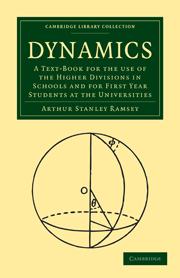 Dynamics
Dynamics Book contents
- Frontmatter
- PREFACE
- Contents
- Chapter I INTRODUCTION
- Chapter II VECTORS
- Chapter III RECTILINEAR MOTION. KINEMATICS
- Chapter IV RECTILINEAR MOTION. KINETICS
- Chapter V KINEMATICS IN TWO DIMENSIONS
- Chapter VI DYNAMICAL PROBLEMS IN TWO DIMENSIONS
- Chapter VII HARMONIC MOTION
- Chapter VIII MOTION UNDER CONSTRAINT
- Chapter IX THE LAW OF REACTION. GENERAL PRINCIPLES
- Chapter X GENERAL PROBLEMS
- Chapter XI IMPULSIVE MOTION
- Chapter XII POLAR COORDINATES. ORBITS
- Chapter XIII MOMENTS OF INERTIA
- Chapter XIV MOTION OF A RIGID BODY. ENERGY AND MOMENTUM
- Chapter XV EQUATIONS OF MOTION OF A RIGID BODY
- Chapter XVI MISCELLANEOUS PROBLEMS
- Chapter XVII SMALL OSCILLATIONS
Chapter IV - RECTILINEAR MOTION. KINETICS
Published online by Cambridge University Press: 07 September 2010
- Frontmatter
- PREFACE
- Contents
- Chapter I INTRODUCTION
- Chapter II VECTORS
- Chapter III RECTILINEAR MOTION. KINEMATICS
- Chapter IV RECTILINEAR MOTION. KINETICS
- Chapter V KINEMATICS IN TWO DIMENSIONS
- Chapter VI DYNAMICAL PROBLEMS IN TWO DIMENSIONS
- Chapter VII HARMONIC MOTION
- Chapter VIII MOTION UNDER CONSTRAINT
- Chapter IX THE LAW OF REACTION. GENERAL PRINCIPLES
- Chapter X GENERAL PROBLEMS
- Chapter XI IMPULSIVE MOTION
- Chapter XII POLAR COORDINATES. ORBITS
- Chapter XIII MOMENTS OF INERTIA
- Chapter XIV MOTION OF A RIGID BODY. ENERGY AND MOMENTUM
- Chapter XV EQUATIONS OF MOTION OF A RIGID BODY
- Chapter XVI MISCELLANEOUS PROBLEMS
- Chapter XVII SMALL OSCILLATIONS
Summary
4·1. In the last chapter we discussed the measurement of the velocity and acceleration of a point moving in a straight line. We must now begin to study the branch of Dynamics called Kinetics, which is concerned with the effects of forces on the motion of bodies.
The definitions and laws of motion enunciated by Newton in the seventeenth century form the foundation of a science of dynamics which has been developed by many other mathematicians. This dynamics, now commonly called ‘Newtonian Mechanics,’ is the basis of all the theoretical work in applied mechanics or engineering and the results of the theory have been and are still being confirmed every day by numerous appeals to experiment; so that nowadays no one questions whether the theory is adequate to furnish reliable results in common matters. It is only when on the one hand we begin to investigate what is relatively very small, e.g. the interior of an atom, or on the other hand when we leave the Earth and apply the Newtonian theory on a much wider scale that discrepancies can be detected, and even here it may be remarked that Newtonian Mechanics has proved adequate to enable astronomers to predict the time of eclipses with an accuracy that would hardly have been possible had the foundations of dynamics been radically at fault.
From a philosophical standpoint Newton's definitions and laws of motion offer much scope for criticism, particularly his assumptions of absolute time and space.
- Type
- Chapter
- Information
- DynamicsA Text-Book for the Use of the Higher Divisions in Schools and for First Year Students at the Universities, pp. 24 - 51Publisher: Cambridge University PressPrint publication year: 2009First published in: 1929


